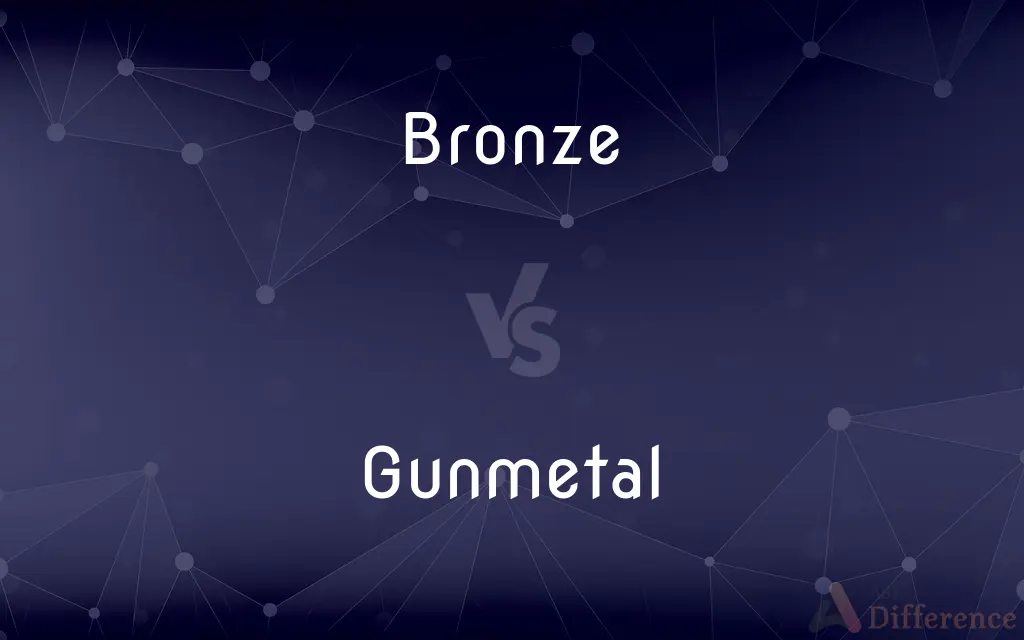Bronze vs. Gunmetal — What's the Difference?
By Fiza Rafique & Urooj Arif — Updated on March 4, 2024
Bronze is an alloy primarily of copper and tin, known for its durability and workability, whereas gunmetal, a type of bronze, includes zinc and has higher mechanical properties.

Difference Between Bronze and Gunmetal
Table of Contents
ADVERTISEMENT
Key Differences
Bronze is a historical metal alloy, mainly consisting of copper and tin, used for millennia for tools, weapons, and sculptures due to its corrosion resistance and ease of casting. Whereas gunmetal, also a bronze alloy, incorporates zinc and sometimes lead, enhancing its strength and wear resistance, making it ideal for heavy-duty applications like cannons and gears.
Bronze offers a distinctive golden-brown color, making it a favorite for artistic and decorative purposes. On the other hand, gunmetal, with its higher zinc content, typically presents a darker finish, which is preferred for its aesthetic appeal in architectural and marine hardware.
The composition of bronze can vary, but it generally contains a higher percentage of tin compared to gunmetal. This composition makes bronze slightly softer but easier to work with for detailed artistry. Conversely, gunmetal's added zinc and lead (in some variants) afford it greater hardness and resistance to impact, suitable for more functional applications.
While both alloys exhibit good corrosion resistance, bronze is particularly noted for its performance in marine environments, thanks to its tin content. Gunmetal, however, due to its specific alloying elements like zinc, offers enhanced resistance to steam and high-pressure environments, making it a top choice for valve and pump applications.
Bronze has a storied past, being central to entire eras of human civilization, such as the Bronze Age. Gunmetal, while also historically significant, is more noted for its industrial and military applications, particularly in the manufacture of cannons and naval fittings.
ADVERTISEMENT
Comparison Chart
Primary Composition
Copper and tin
Copper, tin, and zinc
Color
Golden-brown
Darker, duller finish
Hardness
Generally softer
Harder, due to zinc and sometimes lead
Applications
Artistic, decorative, marine
Industrial, valves, gears
Historical Significance
Central to the Bronze Age, widely used in art and tools
Noted for military and industrial use
Compare with Definitions
Bronze
Widely used in sculptures, coins, and architectural details.
The artist chose bronze for the sculpture to utilize its warm, golden hue.
Gunmetal
Ideal for heavy-duty industrial components, such as bearings and bushings.
The factory installed gunmetal bushings for their high-load bearing capacity.
Bronze
Central to human civilization during the Bronze Age.
Bronze tools and weapons marked a significant advancement in ancient technology.
Gunmetal
Exhibits higher mechanical properties compared to traditional bronze.
Gunmetal's composition makes it resistant to steam and high temperatures.
Bronze
An alloy primarily of copper and tin, used historically for its durability and workability.
The ancient statue was made of bronze, showcasing the alloy's lasting beauty over centuries.
Gunmetal
Can include varying amounts of zinc and sometimes lead.
The addition of lead in gunmetal improves its machinability for complex parts.
Bronze
The tin content in bronze can vary, affecting its hardness and color.
High-tin bronze offers a harder finish, suitable for making durable bells.
Gunmetal
A type of bronze alloy that includes zinc, known for its strength and wear resistance.
Gunmetal is often used for valves and gears due to its durability under pressure.
Bronze
Known for its corrosion resistance, especially in marine environments.
Bronze fittings are preferred for boats because they resist saltwater corrosion.
Gunmetal
Known for its use in cannons and naval hardware.
Historical cannons were often made of gunmetal for its resistance to bursting.
Bronze
Bronze is an alloy consisting primarily of copper, commonly with about 12–12.5% tin and often with the addition of other metals (such as aluminium, manganese, nickel or zinc) and sometimes non-metals or metalloids such as arsenic, phosphorus or silicon. These additions produce a range of alloys that may be harder than copper alone, or have other useful properties, such as strength, ductility, or machinability.
Gunmetal
Gun metal, also known as red brass in the United States, is a type of bronze; an alloy of copper, tin and zinc. Proportions vary but 88% copper, 8–10% tin, and 2–4% zinc is an approximation.
Bronze
Any of various alloys of copper and tin in various proportions, sometimes with traces of other metals.
Gunmetal
A grey corrosion-resistant form of bronze containing zinc.
Bronze
An alloy of copper and tin, to which small proportions of other metals, especially zinc, are sometimes added. It is hard and sonorous, and is used for statues, bells, cannon, etc., the proportions of the ingredients being varied to suit the particular purposes. The varieties containing the higher proportions of tin are brittle, as in bell metal and speculum metal.
Gunmetal
An alloy of copper with 10 percent tin.
Bronze
Made from or consisting of bronze
Gunmetal
A dark grey or bluish-grey colour; gunmetal grey.
Gunmetal
A type of bronze used for parts subject to wear or corrosion (especially corrosion by sea water)
Common Curiosities
What makes gunmetal suitable for valve and pump manufacturing?
Gunmetal's enhanced resistance to steam and high-pressure environments is ideal for these applications.
What distinguishes gunmetal from bronze?
Gunmetal is a type of bronze that includes zinc, offering higher strength and wear resistance.
Why is bronze preferred for marine applications?
Its corrosion resistance, especially against saltwater, makes bronze ideal for marine hardware.
What is bronze?
Bronze is an alloy mainly composed of copper and tin, recognized for its durability and historical significance.
How does the color of bronze compare to gunmetal?
Bronze typically has a golden-brown color, while gunmetal is darker and duller due to its zinc content.
Why is gunmetal preferred for heavy-duty applications?
Its higher mechanical properties and resistance to wear make it suitable for heavy-duty industrial components.
What are the main uses of bronze?
Bronze is widely used for artistic, decorative, and marine applications.
What is the historical significance of bronze?
Bronze has been central to human civilization, notably during the Bronze Age, for its use in tools, weapons, and art.
Can bronze and gunmetal be used interchangeably?
While both have similar applications, their differing properties make them better suited for specific uses, with bronze preferred for art and decoration and gunmetal for industrial purposes.
What is the advantage of including lead in gunmetal?
Lead improves the machinability of gunmetal, making it easier to produce complex parts.
Is gunmetal harder than bronze?
Yes, the addition of zinc and sometimes lead makes gunmetal harder than traditional bronze.
What additional elements are in gunmetal that are not typically in bronze?
Gunmetal includes zinc and sometimes lead, unlike traditional bronze.
Are there different types of bronze?
Yes, there are several types of bronze, each with varying compositions for different uses.
Can the composition of bronze vary?
Yes, the tin content in bronze can vary, affecting its hardness, color, and other properties.
How does the addition of zinc affect gunmetal's properties?
Zinc increases gunmetal's strength and wear resistance, making it suitable for more demanding applications.
Share Your Discovery

Previous Comparison
Kindergarten vs. Montessori
Next Comparison
Substantive vs. SuperficialAuthor Spotlight
Written by
Fiza RafiqueFiza Rafique is a skilled content writer at AskDifference.com, where she meticulously refines and enhances written pieces. Drawing from her vast editorial expertise, Fiza ensures clarity, accuracy, and precision in every article. Passionate about language, she continually seeks to elevate the quality of content for readers worldwide.
Co-written by
Urooj ArifUrooj is a skilled content writer at Ask Difference, known for her exceptional ability to simplify complex topics into engaging and informative content. With a passion for research and a flair for clear, concise writing, she consistently delivers articles that resonate with our diverse audience.














































